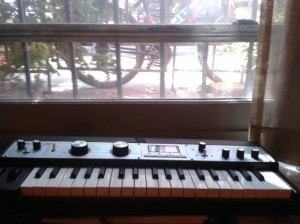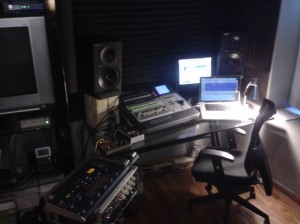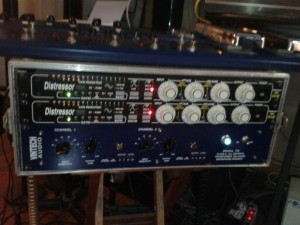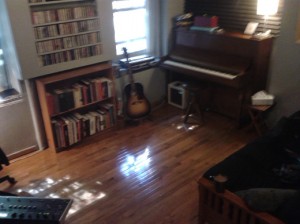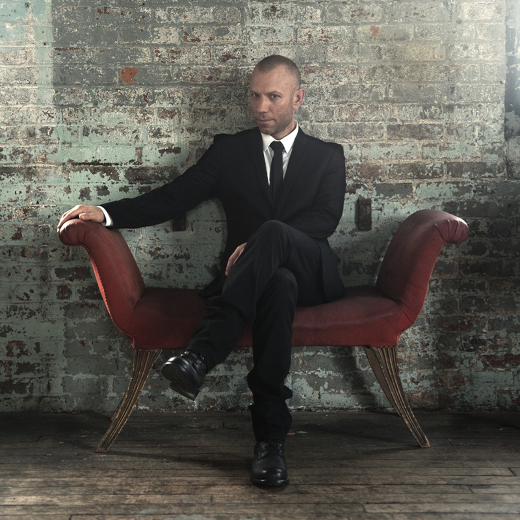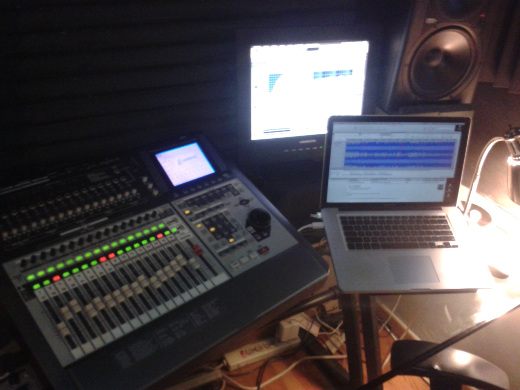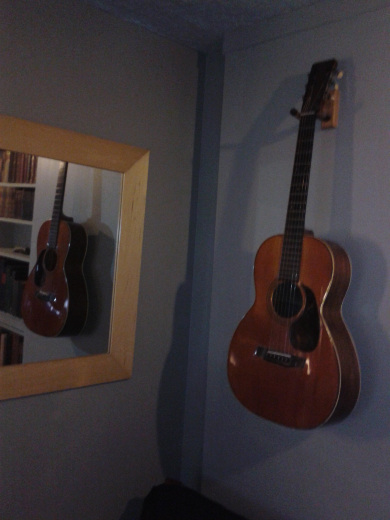Return of the Record Label Recording Studio – ECR Music Group’s NYC Home Base
Is the record label recording studio back on the rise?
Time was when a record company and their own recording studio were inseparable. Some of the most cherished music ever has sprung from facilities that were entirely owned and operated by the labels that constructed them: Atlantic, Capitol, Columbia, Motown, RCA, and many more — the list is long and legendary.
Many of these label-run studios are gone or transformed, nostalgic symbols of a different era in the music industry. But the fact is that these bundled business models are still running, and they can power a positive cycle of creativity and commerce.
One example is ECR Music Group, which maintains its own dedicated studio for the exclusive use of its artists. It’s on a bucolic block in New York City’s West Village, in an assuming ground-floor apartment that just happens to be a magical place to make music.
Secret Weapons
ECR founder Blake Morgan is excited when he’s inside the studio, and it’s easy to see why.
A lifelong music warrior, Morgan has transformed from being a major-label recording artist to an independent label entrepreneur. Since starting ECR as Engine Company Records in 2002, the label has always experienced growth – the result of a head-of-the-curve thinking, and a sparkling partnership wherein all ECR artists and labels own 100% of their master recordings.
It’s an approach that has attracted a notable roster. Signing on for the ride are some highly distinguished artists that include David Cloyd, James McCartney, Janita, Lesley Gore, Melissa Giges, 20th Century Duos, and Morgan himself.
With a personable philosophy at its core, the ECR studio is fittingly down-to-earth. This is no overbuilt room from the Planet Future – it’s an atmospheric home for ideas, with aged dark wood, an array of hand-picked instruments, and a recording setup that Morgan is uniquely equipped to manage.
“One of the great things I’ve had in my career, that a lot of people have less and less, is incredible mentors who are giants in the recording world,” Morgan says. “Terry Manning and Phil Nicolo, these two guys have been incredible Obi-Wan Kenobi’s for me.
“But even more than mentors teaching you what you should do, I think what’s even more important is that they teach you what you shouldn’t do, and what you don’t need. That’s a big reason why I’ve been using this console over the last 12 years.”
“This console” is a piece of gear that very few audio engineers have even thought about in a long time, much less leaned on to power a high-fidelity list of record releases like the ones that Morgan has engineered and produced. It’s a Roland VS-2480, and you’ll pry this digital studio workstation from Blake Morgan’s cold dead fingers.
An eye-opener when it debuted in the year 2000, the VS-2480 stood as the world’s first self-contained 24-track/24-bit/96 kHz digital recording workstation with onboard effects. If that weren’t enough, it had the option to burn CDs all by itself – remember those?
There’s no DAW in the ECR studio. You won’t find ProTools hiding on the backend of the music computer somewhere, because there isn’t one. Instead, Morgan leans exclusively on the VS-2480 because he’s come to know it so well. “This console is my light saber,” says Morgan, continuing with the Star Wars inspiration. “Not only have I mastered it, but it’s also important to me because it’s portable. I can bring it to a big studio and record drums, then bring everything back here.
“It’s 24-bit, fully automated, set up like a console with flying faders – this is an incredibly powerful machine. But the most important reason that it’s powerful is because I’m able to make music on it without sacrificing quality.”
Morgan spent his own time under the gun in world-class studios during the late 1990’s, when recording as an artist on Phil Ramone’s N2K Sony/Red Label. The experience seems to have made him determined to make the best recordings possible in an equal-and-opposite fashion.
“As Phil Nicolo says, ‘It isn’t the plane that gets you to Cleveland, it’s the pilot,’” Morgan relates. “Making music with no overhead in this place, which I own, has decoupled what I do in the studio from financial choices: I’m able to make a record here for a year at the cost someone else has to expend in two weeks. And anyone who tells you that the clock and the dollars don’t affect the art on the record are lying to you.
“When you’re not watching the clock, the recording facility becomes a creative environment, and you can dare to suck. That’s something you usually can’t do until you’re at the top level: U2, Grizzly Bear — they can spend as much time as they want in the studio. So can we.”
Live it to the Limit
ECR’s setup is based on embracing the limitations – all the better to get to the heart of an artist’s sound.
The most recent example is the newly-released album Just When I let Go by Melissa Giges. Recorded, mixed and mastered completely in Morgan’s apartment studio (except for the drums which were tracked at Phil Nicolo’s Studio 4 in Philadelphia), it’s an instantly engaging record that places a high emphasis on the listening experience – audiophile and creative concepts merge in the production, with Giges’ arresting songs at the center of it all.
Obviously, there’s more to Morgan’s hi-fi sound than that Roland workstation. Another major factor is what he refers to as his “magic sidecar,” consisting of two Neve 1272 line amplifiers, two Empirical Labs Distressors, and two Vintech Dual 72 mic pres.
“The 1272 is my favorite preamp in the world, and it’s also the simplest, with no EQ,” Morgan says. “If I want EQ, this is where the mentor thing comes in – how about moving the microphone an inch further away from the acoustic guitar? Or if we want a darker sound, let’s use the ribbon mic.
“The Distressor is my favorite compressor: It’s a very malleable compressor, as you know, with many different settings. To ape tape compression, I’m usually running these Distressors at 2:1, distortion on, short attack, fast release, with somewhere between 1-3 DB of compression.
“So if I record drums, I run two tracks at a time through my sidecar. Now I’m mixing on a digital console, but basically I’m capturing the spirit of the Neve console, so everything has the feeling of being bound together. Listen for a second and it feels analog — it’s fuzzy, but not distorted.”
The pleasant live room/control room — which is the living room of the one-bedroom apartment — plays its role as well. Paneled in cherry wood and outfitted with a 1985 Steinway model 1098 upright piano, guitars, synths, and a comfortable couch, the vibe and acoustics are of the variety that money can’t buy. Even better, the studio’s neighbors have never complained about noise levels, even though Morgan has recorded everything from vocals to saxophone, trumpet, sitar, and a string quartet there.
“I’ve recorded everything you can think of here,” notes Morgan. “If I need a bigger room, I can pack up and go there. I love rooms all over the city, and Philadelphia’s Studio 4 is great for big drums. There’s usually one stage on each record where we need a larger room. So pick a room and go. Everything else gets done here.”
As noted above, Morgan does his own mastering as well. While he uses his sidecar to emulate 2-inch tape in the tracking phase, he’ll tweak his setup to work like ½-inch tape for mastering.
“People say you shouldn’t master what you mix, because you should be in a different environment with different speakers, and that makes absolutely no sense to me,” says Morgan, who studied mastering with Nicolo and practiced the craft extensively on other people’s records before digging into his own. “I’m at my best here, so why wouldn’t I want to do it here? As opposed to someone else who’s 1000 miles away.”
No Artists Are Harmed…
For Blake Morgan, the ECR studio is a place to make great recordings. But it’s about more than that, as well.
After some of the traumatic experiences that occurred during his own early career, Morgan is diligent about protecting artists from every angle. He’s come out strong in the fight for royalty fairness against forces like Pandora http://www.huffingtonpost.com/blake-morgan/pandora-radio_b_3530363.html, and so it follows that safeguarding the creative muse is a natural instinct.
“This is the most important thing,” he says, “were not done with the record until you, the artist, has no itch about anything that’s bothering you. Until we know that it’s really right, let’s keep taking a look at it. If you ask anyone on the ECR label they would tell you, I guarantee, that this has been their favorite record-making process.”
Recording music in this manner all comes back to those self-imposed borders that Blake Morgan loves, the ones that can be terrifying or exhilarating, depending on how you look at it.
“’Limitation’ is not a four-letter word: It’s a crucial artistic barometer,” states Morgan. “I’m really grateful that I’ve had that dichotomy of working at the most famous studios in the world, and then making music here. You have to learn how to separate the stuff that matters from the stuff that doesn’t matter. And the stuff that matters — really fucking matters.”
— David Weiss
Please note: When you buy products through links on this page, we may earn an affiliate commission.








